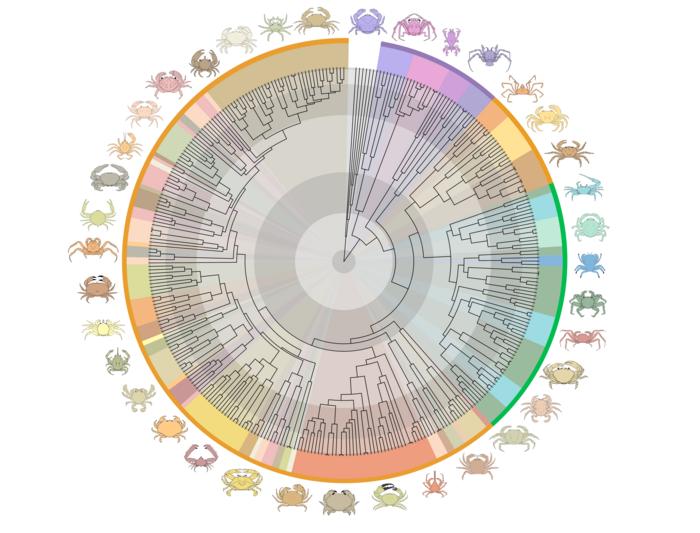Crabs are unique and continuously evolving animals, often moving their lifestyles out of marine environments for other environments to do so. The most popular food species can be fully marine (snow crab) or estuarine (Maryland blue crab, Dungeness crab). Some highly terrestrial species can climb trees if they are in higher levels, while others will die if they are fully immersed in water as adults.

Credit: Figure by Joanna Wolfe, line drawings by Javier Luque and Harrison Mancke.
Crabs are unique and continuously evolving animals, often moving their lifestyles out of marine environments for other environments to do so. The most popular food species can be fully marine (snow crab) or estuarine (Maryland blue crab, Dungeness crab). Some highly terrestrial species can climb trees if they are in higher levels, while others will die if they are fully immersed in water as adults.
In a new study in Systematic Biology, an international team of researchers, led by Joanna Wolfe, postdoctoral researcher in the Department of Organismic and Evolutionary Biology at Harvard, asked how many times and when did true crabs (Brachyura) leave the marine environment to live in other environments. The study, whose project spanned almost 20 years, found that true crabs not only left the marine environment 7 to 17 times, but they are also older than previous estimates, dating to the Middle Triassic alongside some of the earliest dinosaurs, 45 million years older than the previously assumed Jurassic.
True crabs encompass over 7,600 species in 109 families. For millions of years some species of crabs have left the marine environment to live in other environments, including intertidal, terrestrial, and freshwater. For most arthropods, terrestrialization, the process of leaving the oceans for land, only occurred once (insects, myriapods) or possibly a few times (arachnids), with most events happening more than 300-million-years ago.
“Our research has shown that over the last 100 million years, true crabs have independently populated land and freshwater around 17 times,” said Wolfe. Most of these 17 crab groups are only able to survive in semi-terrestrial habitats (intertidal zones, lagoons, and estuaries). The majority of the crabs that are the most independent from seawater (such as fiddler crabs, vampire crabs, and land crabs) are concentrated in one species-rich group of the family tree.
The researchers assembled three new datasets for true crabs. A molecular phylogeny of 344 species from 88 true crab families, that included both marine and non-marine groups. Fossil calibrations composed of 36 “vetted” calibrations and the entire documented crab fossil record from the Paleobiology Database. And, last, a collection of natural history data (habitat, larval development, respiratory morphology, types of setae, burrowing, diurnal/nocturnal activity) to help them holistically classify each crab species from their phylogeny into a gradient of terrestriality.
From the datasets, the researchers were able to reconstruct the phylogenetic relationships. They applied Bayesian methods, originally developed in epidemiology to study how viruses like COVID-19 evolved, to determine the timing of evolution. This allowed them to then estimate the number of ecological transitions from marine environments.
The study categorized two pathways to terrestrialization. One where the animal goes from fully marine to land through intertidal zones, beaches and coastal forests, and jungles. The other where the animal goes from fully marine to land indirectly through estuarine, submerged freshwater, riverbanks, and finally coastal forests and jungles.
“We saw quite a large number of convergent events of terrestrialization with certain sets of traits,” Wolfe said, “and that gives us some ability to predict what may have happened in other groups. That’s the goal, to be able to apply what we see across the tree of life.”
The study aides in better understanding of convergent evolution and the adaptation of different organisms from life in the water to life on land. Biologists want to know how to predict if a phenotype, or morphology would evolve in a group. Crabs provide an important window into the early processes of adaptation to dramatically new environments and the different degrees of evolutionary constraint that may help predict these pathways.
“Crabs continue to amaze us and studies such as this allow us to learn more about habitat transitions and timing of these important events,” said co-author Assistant Professor Heather D. Bracken-Grissom, Florida International University.
Surprisingly, the researchers also found evidence in the data of at least 2 to 3 times when crabs returned to fully marine life. “Crabs do not have the goal of living on land,” said Wolfe, “Our results suggest it’s easier to move from fully marine to intertidal or estuarine environments, and it’s up to one hundred times more difficult to transition to living more independently from water, like a fiddler crab, which is mostly on land, because they have more physiological adaptations. Evolution is ongoing, and the niches occupied by organisms change over time; there is no perfect adaptation than can persist forever.”
Journal
Systematic Biology
DOI
10.1093/sysbio/syad066
Article Title
Convergent adaptation of true crabs (Decapoda: Brachyura) to a gradient of terrestrial environments




